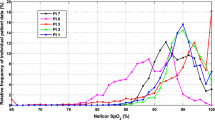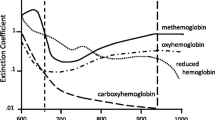Abstract
Most anesthesiologists, relying upon sales presentations from salesmen from oximeter manufacturers, believe that if an oximeter produces a steady signal with a good pulse amplitude, the numbers are always believable in the absence of interference from external light sources or from intravenous dyes. Here I report a case in which an oximeter appeared to be working properly yet displayed values which were falsely low. Trust in the oximeter resulted in delayed identification of the problem.
Similar content being viewed by others
References
Scheller MS, Unger RJ, Kelner MJ. Effects of intravenously administered dyes on pulse oximetry readings. Anesthesiology 1986; 65: 550–552.
Sidi A, Paulus DA, Rush W,et al. Methylene blue and indocyanine green artifactually lower pulse oximetry readings of oxygen saturation. J Clin Monit 1987; 3: 249–256.
Brooks TD, Paulus DA, Winkle WE. Infrared heat lamps interfere with pulse oximeters. Anesthesiology 1984; 61: 630.
Block FE Jr. Interference in a pulse oximeter from a fiberoptic light source. J Clin Monit 1987; 3: 210–211.
Hanowell L, Eisele JH Jr, Downs D. Ambient light affects pulse oximeters. Anesthesiology 1987; 67: 864–865.
Eisenkraft JB. Pulse oximeter desaturation due to methemoglobinemia. Anesthesiology 1988; 68: 279–282.
Block FE Jr, Detko GJ Jr. Minimizing Interference and False Alarms from Electrocautery in the Nellcor N-100 Pulse Oximeter. J Clin Monit 1986; 2: 203–205.
Alpert CC, Cooke JE. Extending the life of oximetry monitoring probes. Anesth Analg 1986; 65: 826–827.
Racys V, Nahrwold ML. Reusing the Nellcor pulse oximeter probe: Is it worth the savings? Anesthesiology 1987; 66: 713.
Kao J, Badgwell JM. Reusing the Nellcor pulse probe: clarification. Anesthesiology 1987; 67: 866.
Author information
Authors and Affiliations
Rights and permissions
About this article
Cite this article
Block, F.E. Case report: Delayed recognition of an oximeter malfunction. J Clin Monit Comput 6, 119–121 (1989). https://doi.org/10.1007/BF01720422
Accepted:
Issue Date:
DOI: https://doi.org/10.1007/BF01720422




